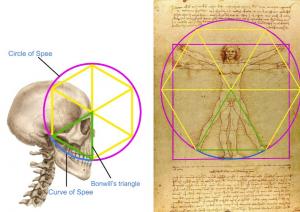An Irish Dentist May Have Solved da Vinci's 500-Year-Old Riddle
A London has discovered an embedded mathematical code in human jaw Leonardo da Vinci's Vitruvian Man that could
LONDON, LONDON, UNITED KINGDOM, July 7, 2025 /EINPresswire.com/ -- A London-based dentist may have solved one of art history's greatest mysteries by cracking a 500-year-old riddle hidden within Leonardo da Vinci's iconic Vitruvian Man. Dr. Rory Mac Sweeney has discovered that the Renaissance master embedded precise mathematical principles governing ideal human form within his famous drawing.Published in the Journal of Mathematics and the Arts, Dr. Mac Sweeney's research reveals that Leonardo's explicit reference to "an equilateral triangle" between the figure's legs corresponds to Bonwill's triangle – a geometric principle governing optimal human jaw function that wasn't formally established until 1864.
"The solution has been hiding in plain sight within Leonardo's own notes," explains Dr. Mac Sweeney. "He wrote that 'the space between the legs will be an equilateral triangle' – and this triangle matches exactly with modern understanding of optimal dental anatomy."
The breakthrough shows that Leonardo's construction yields mathematical ratios of 1.64-1.65, which closely match the tetrahedral ratio of 1.633 found throughout nature for optimal spatial organization. This same ratio appears in human cranial architecture and represents the mathematical foundation for peak structural efficiency.
The discovery suggests that the Vitruvian Man isn't just artistic idealization, but scientific documentation of optimal human anatomical relationships. Modern research confirms that human cranial architecture consistently exhibits ratios of 1.64 ± 0.04 – measurements found exclusively in humans and matching exactly what Leonardo documented five centuries ago.
"This research reveals that Leonardo identified geometric principles of optimal spatial organization that contemporary science recognizes as fundamental to human anatomical optimization," Dr. Mac Sweeney concludes.
The findings could have significant implications for medical fields including dentistry, plastic surgery, and orthopedics.
Contact: Dr. Rory Mac Sweeney
@luciddreamyoga
The paper can be read here
https://doi.org/10.1080/17513472.2025.2507568
Rory Mac Sweeney
igdp
+44 7801 846111
email us here
Legal Disclaimer:
EIN Presswire provides this news content "as is" without warranty of any kind. We do not accept any responsibility or liability for the accuracy, content, images, videos, licenses, completeness, legality, or reliability of the information contained in this article. If you have any complaints or copyright issues related to this article, kindly contact the author above.
BMJ Physiotherapy Expands to One@Kentridge Medical Centre Adjacent to NUH
New Book Reveals Untold Story of Royalty in America
Puraffinity and U.S. Army Corps of Engineers Partner to Advance PFAS Remediation Technologies
Kalendarium
Więcej ważnych informacji
 Jedynka Newserii
Jedynka Newserii

 Jedynka Newserii
Jedynka Newserii

Prawo

KE proponuje nowy Fundusz Konkurencyjności. Ma pobudzić inwestycje w strategiczne dla Europy technologie
W środę 16 lipca Komisja Europejska przedstawiła projekt budżetu na lata 2028–2034. Jedna z propozycji zakłada utworzenie Europejskiego Funduszu Konkurencyjności o wartości ponad 400 mld euro, który ma pobudzić inwestycje w technologie strategiczne dla jednolitego rynku. Wśród wspieranych obszarów znalazła się obronność i przestrzeń kosmiczna. Na ten cel ma trafić ponad 130 mld euro, pięciokrotnie więcej niż do tej pory.
Firma
Były prezes PGE: OZE potrzebuje wsparcia magazynów energii. To temat traktowany po macoszemu

Choć udział odnawialnych źródeł energii w miksie energetycznym Polski jest stosunkowo wysoki i rośnie, to ten przyrost jest chaotyczny i nierównomiernie rozłożony miedzy technologiami – wskazuje Forum Energii. Dodatkowo OZE potrzebują wsparcia magazynów energii, a zdaniem Wojciecha Dąbrowskiego, prezesa Fundacji SET, ten temat jest traktowany po macoszemu. Brak magazynów powoduje, że produkcja energii z OZE jest tymczasowo wyłączana, co oznacza marnowanie potencjału tych źródeł.
Infrastruktura
Wzrost wynagrodzeń ekip budowlanych najmocniej wpływa na koszty budowy domu. Zainteresowanie inwestorów mimo to nieznacznie wzrasta

Budowa metra kwadratowego domu w Polsce kosztuje od 5,55 do 6 tys. zł w zależności od województwa – wynika z najnowszych analiz firmy Sekocenbud. Najdrożej jest w Warszawie, gdzie cena za metr kwadratowy domu przekroczyła już 6,2 tys. zł. Na przyrosty kosztów budowy domu wpływają zarówno drożejące materiały budowlane, jak i wyższe wynagrodzenia pracowników. Inwestorzy nie rezygnują jednak z budowy domów jednorodzinnych, co ma związek m.in. z wciąż wysokimi cenami mieszkań czy też obniżką stóp procentowych.
Partner serwisu
Szkolenia

Akademia Newserii
Akademia Newserii to projekt, w ramach którego najlepsi polscy dziennikarze biznesowi, giełdowi oraz lifestylowi, a także szkoleniowcy z wieloletnim doświadczeniem dzielą się swoją wiedzą nt. pracy z mediami.









.gif)

 |
| |
| |
|